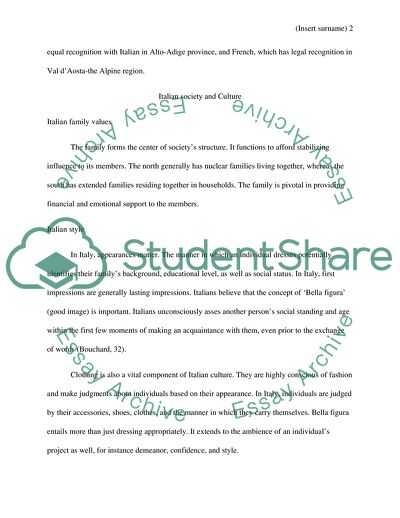
- Home
- Free Samples
- Premium Essays
- Editing Services
- Extra Tools
- Essay Writing Help
- About Us
- Studentshare
- Subjects
- Miscellaneous
- Presentation about the Italien Culutre (Interculutural Communications)
Presentation about the Italien Culutre (Interculutural Communications) - Essay Example

- Subject: Miscellaneous
- Type: Essay
- Level: Masters
- Pages: 4 (1000 words)
- Downloads: 0
- Author: ludiejakubowski
Extract of sample "Presentation about the Italien Culutre (Interculutural Communications)"
Italian is Italy’s native language, with 93% of the populace being native Italian speakers. Close to half the populace has a regional dialect as their mother tongue. Numerous dialects are mutually unintelligible, hence linguists consider them as separate languages, but they are not recognized officially. Northern minority languages include; Slovene, Ladin, German, which has equal recognition with Italian in Alto-Adige province, and French, which has legal recognition in Val d’Aosta-the Alpine region.
The family forms the center of society’s structure. It functions to afford stabilizing influence to its members. The north generally has nuclear families living together, whereas the south has extended families residing together in households. The family is pivotal in providing financial and emotional support to the members. In Italy, appearances matter. The manner in which an individual dresses potentially identifies their family’s background, educational level, as well as social status.
In Italy, first impressions are generally lasting impressions. Italians believe that the concept of ‘Bella figura’ (good image) is important. Italians unconsciously asses another person’s social standing and age within the first few moments of making an acquaintance with them, even prior to the exchange of words (Bouchard, 32). Clothing is also a vital component of Italian culture. They are highly conscious of fashion and make judgments about individuals based on their appearance. In Italy, individuals are judged by their accessories, shoes, clothes, and the manner in which they carry themselves.
Bella figura entails more than just dressing appropriately. It extends to the ambience of an individual’s project as well, for instance demeanor, confidence, and style. Italy’s primary religion is Roman Catholic. Italy has the most catholic churches per capita in the
...Download file to see next pages Read MoreCHECK THESE SAMPLES OF Presentation about the Italien Culutre (Interculutural Communications)
Local Cultural Identities
Global business cultural analysis: Italy
The Top Salesman in West Coast District
Global Business Cultural Analysis: Italy
Cultural Consideration in International Business
Intercultural Language Learning
Linguistic Factors Influencing Translation from English to Arabic
Aboriginal Culture Identity

- TERMS & CONDITIONS
- PRIVACY POLICY
- COOKIES POLICY